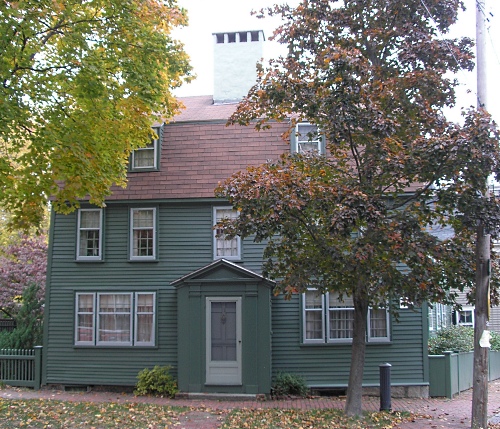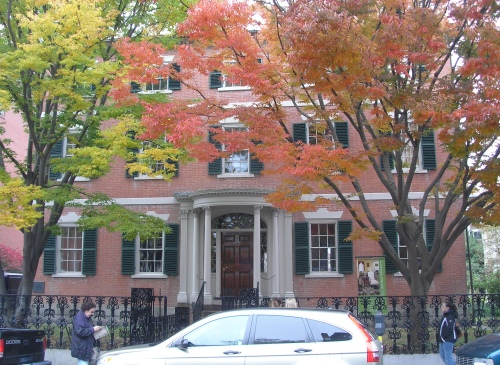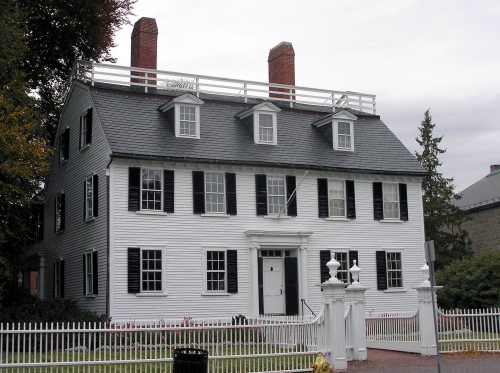John Jenkins House (1799)

According to the plaque on the house at 2 River Street in Salem, it was built in 1799 for John Jenkins, a tailor.

The Glover-Cook-Chapman House, at 101-103 Federal Street in Salem, had many owners over the years. It was built in 1799 or earlier and its first owner was Ichabod Glover. This could be the same Ichabod Glover and house referred to in the following entry, dated April 29, 1802, from the Diary of William Bentley,
Curious incident happened yesterday. As a Company were attending a vendue of the goods of Ichabod Glover, lately deceased, in the chamber of the dwelling house of the deceased which was partly new, but not finished, the floor gave way, & the whole company of forty persons with the furniture & articles for sale fell down together. No person was killed, several were wounded, many bruised & all frightened. The House is in Federal street.
The house was later owned by merchant Samuel Cook, cabinetmaker John Jewett, and next by schoolteacher Rebecca Thayer and printer John Chapman, a publisher of the Salem Register. From 1874, it was home to Benjamin Shreve and his heirs.

The Jonathan Neal House, at 12 Broad Street in Salem, was long believed to have been built in 1767 for Jonathan Neal, a carpenter, who ran a waterfront warehouse. More recent research has indicated that the earliest parts of the house may actually go back to 1652. An early barn on the lot was enlarged by Neal’s father, also named Jonathan, with the central chimney being constructed in 1680 and other work being done later, as attested in deeds from 1720 and 1767, when the gambrel roof was added to the home.

At 18 Winter Street in Salem is a house built in 1848 for Rev. James Conway, who was pastor of St. Mary’s Roman Catholic Church from 1846 until his death in 1857. As described in the Municipal History of Essex County in Massachusetts, Vol. I (1922):
Father Conway was ordained in Boston, July 31, 1831. The early years of his priesthood were spent among the Pennobscot Indians, and as assistant to Father McDermott at St. Patrick’s, Lowell. In 1841 he was appointed to the new parish of St. Peter’s in that town, where he remained until his assignment to Salem.
Once settled in Salem (quoting further from the same book),
His first care was to enlarge and beautify the church, increasing its seating capacity by six hundred. The Sunday school and choir were reorganized in 1846; a parochial residence on Winter street (1848) and later (1852) a much larger one on Mall street were his work; he purchased and opened the Catholic Cemetery in 1849. […] In 1855 “the Hodges estate,” on Walnut street, now Hawthorne Boulevard, was secured as the site of the first distinctively Catholic school in Salem. The Sisters of Notre Dame were introduced to Salem in the fall of 1855 and installed in a schoolhouse and convent set up on the site of the present school. They were insulted and almost attacked by the hostile natives, but persevered in their labors with almost immediate, success. Early in the spring of 1857 ground was broken, and the foundation of the present Church of the Immaculate Conception laid. Its walls were just beginning to rise under his supervision when sudden death called him to his eternal reward, May 24, 1857.
The completed Church of the Immaculate Conception, dedicated on January 10, 1858, continues today as the oldest Catholic church building in the Archdiocese of Boston.

The 350th post at Historic Buildings of Massachusetts is the Gardner-Pingree House in Salem, which is considered to be New England’s greatest example of a Federal-style (or Adamesque) town house. It was erected in 1804-1805 at 128 Essex Street for merchant John Gardner, Jr. and is generally considered to be the work of Samuel McIntire, who certainly did create the mansion‘s exterior ornamentation and interior wood carving. In 1811, financial difficulties forced Gardner to sell his house to Nathaniel West, who then sold it three years later to Captain Joseph White. In 1830, Capt. White was murdered in the house, an event that shook Salem and was followed by a sensational trial with a famed oration by Daniel Webster. The story would have an influence on Poe and Hawthorne. In 1834, the house was sold to David Pingree and remained in the Pingree family until 1933. The house was donated in that year to the Essex Institute, now the Peabody Essex Museum. The restored house is open to the public for tours, usually in conjunction with the museum’s nearby John Ward and Crowninshield-Bentley houses.

Built on Essex Street in Salem around 1727, the Ropes Mansion has been open to the public since 1912. It was built by merchant Samuel Barnard of Deerfield and sold by Barnard’s heirs to Judge Nathaniel Ropes II in 1768. He was a loyalist and died of smallpox as his house was being attacked by a mob of Patriots in 1774. His family went into exile, but reclaimed the house after the Revolutionary War. It remained in the Ropes family until 1907, when sisters Mary and Eliza Ropes bequeathed it as the Ropes Memorial. Various alterations have been made to the interior of the house over the years, most dramatically in 1894, when Colonial Revival modifications were made and the structure was moved back from the street. The building‘s current entryway dates to the 1830s and was inspired by Asher Benjamin‘s American Builder’s Companion (1827). The house also has formal gardens dating to 1912. The house has had several fires: Abigail Ropes burned to death after her dress caught fire in 1839; a disgruntled worker is believed to have started a fire which gutted an addition in 1894; and the third floor attic was damaged in a fire in 2009. Today, the Ropes Mansion is owned by the Peabody Essex Museum.

Wesley United Methodist Church, at 8 North Street in Salem, was designed by Lawrence B. Valk of New York and was constructed in 1888-1889. The local Salem contractors were J.F. Farrin, Joseph N. Parsons, and Joseph N. Peterson. As explained in the Visitor’s Guide to Salem of 1892, at that time Salem had two Methodist churches. One, the
“Lafayette St. Methodist Episcopal Church, at the corner of Harbor street, was built and dedicated in 1853. This society had previously occupied a smaller house of worship on Sewall street, which was again occupied in 1872, as Wesley Chapel, by members who withdrew from the Lafayette St. Society, and who, largely augmented in numbers, re-organized as […] The Wesley Church and, in 1888, erected the large brick and stone church edifice on North street a few doors from Essex. In construction this is quite different from any other church building in the city. By means of sliding doors, the seating capacity can be much increased by connecting the Sunday school rooms, which are on the street end of the building, with the large audience room. The windows of the church being of stained glass present a most beautiful appearance in the evening when services are being held, the brightly lighted interior reflecting attractively through the large gothic memorial window on North street.
The Lafayette Street United Methodist Church moved to a new building at 292 Lafayette Street in 1910 and in 1994 merged with the Wesley United Methodist Church. Since 2007, the Lafayette Street church building has been the First Baptist Church of Salem.